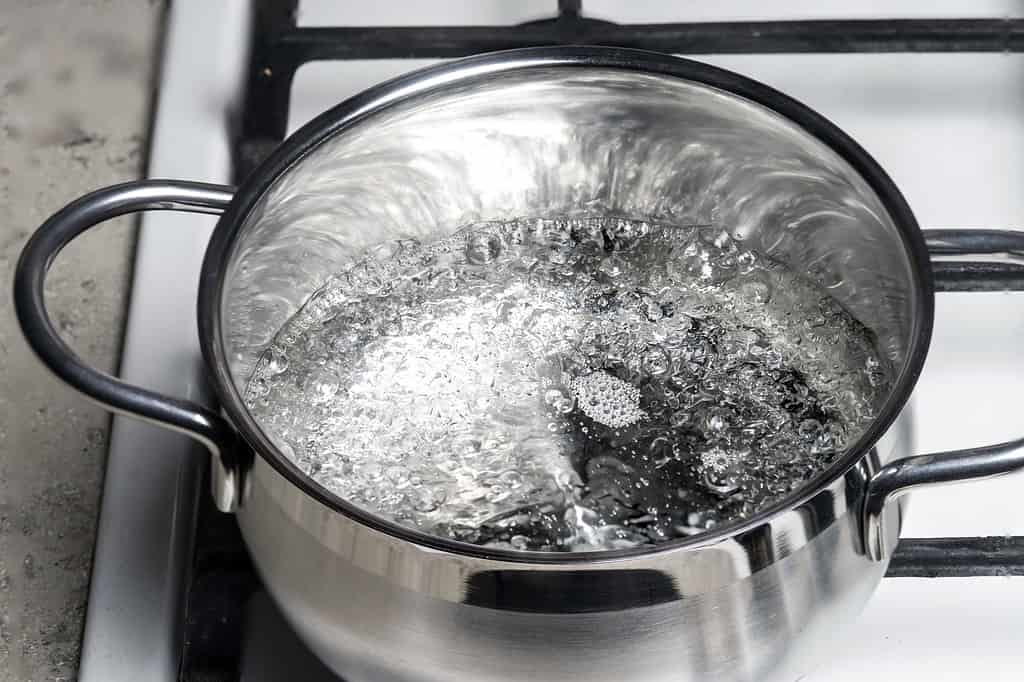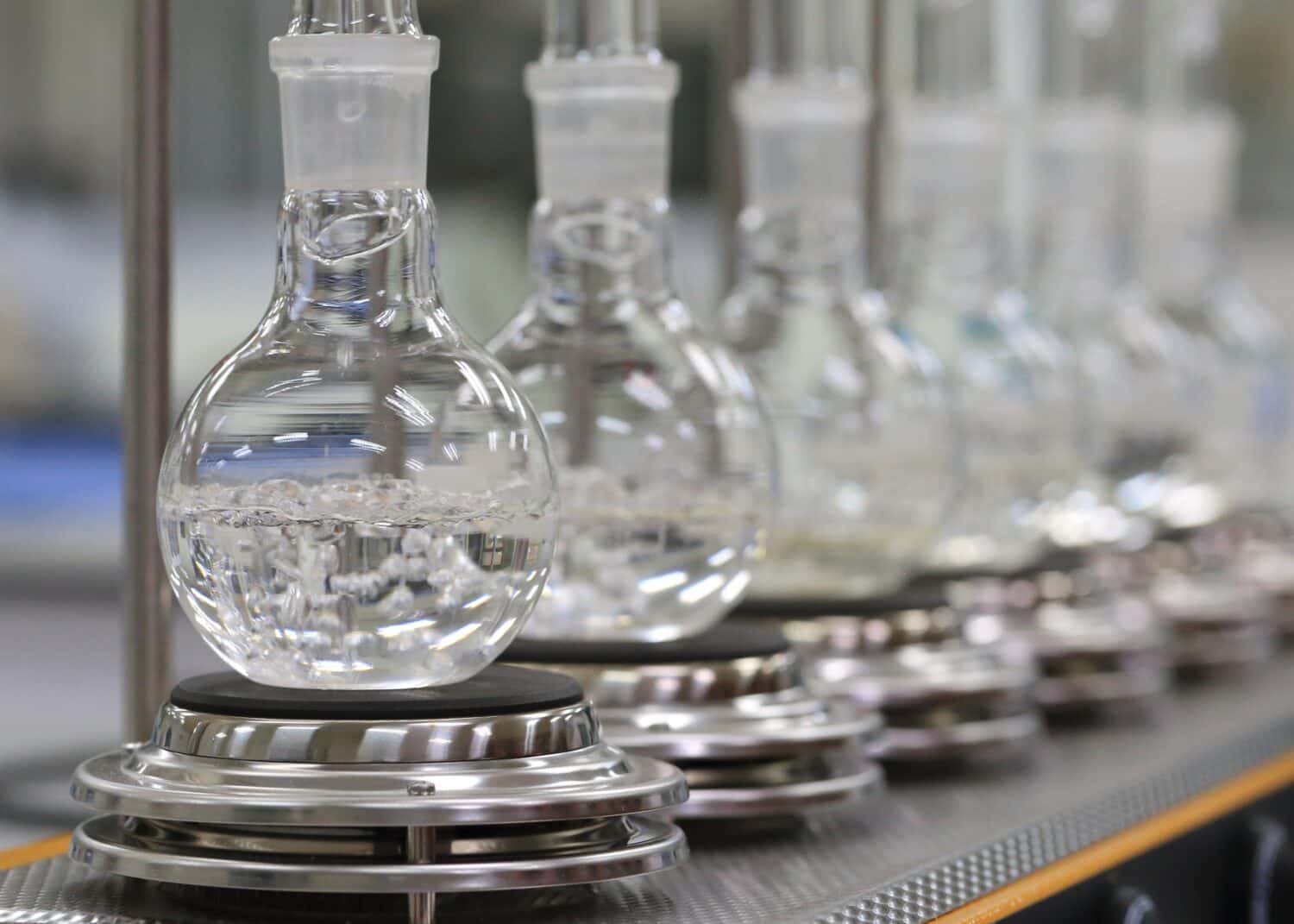The maximum temperature of boiling water varies based on the pressure or impurities that may be present in the water. At one atmosphere (1 atm) of pressure, pure boiling water reaches a temperature of100 °C, or 212 °F. The standard temperature of one atmosphere, or 760 mm of mercury, equals the pressure at sea level. At higher altitudes, the pressure decreases, and so does the boiling point of water.
What Happens When Water Boils?

When water boils it transitions from a liquid phase to a gaseous phase.
©VladK213/iStock / Getty Images Plus via Getty Images
Water boils when it reaches the temperature needed to transition from its liquid phase to its gaseous phase. As molecules of water reach this temperature, they convert from liquid to steam. You can see this happening as bubbles begin to form along the bottom and sides of a heated pot of water and rise to the surface. If the pot has a lid, the gas may condense back into a liquid and return to the pot. If not, the water vapor escapes as steam into the surrounding atmosphere.
Does Water Keep Getting Hotter as It Boils?

As liquid water reaches its boiling point, it is released as steam into the atmosphere.
©Toa55/Shutterstock.com
When water reaches its boiling point, it converts to steam. This steam escapes from the vessel in which the remaining liquid water continues to boil. Gradually, more and more of the water reaches the same boiling point and escapes. The remaining water does not keep getting hotter as it continues to boil. It simply continues to transition from liquid to gas, until it all boils away or the heat source is removed.
What Effect Does Pressure Have on Boiling Water?
The boiling point of any liquid substance equals the temperature at which the vapor pressure of that liquid equals the surrounding atmospheric pressure. This property can be demonstrated mathematically with the Clausis-Clapeyron Equation. It is a bit complicated to explain fully here, but essentially the equation shows that as pressure decreases, so does the boiling point of water. And as pressure increases, the boiling point of water increases, too.
How Does Altitude Affect Boiling Water?

Image: AgriTech, Shutterstock
©AgriTech/Shutterstock.com
At sea level, the pressure equals 760 mm of mercury, or 1 atm of pressure. At this standard pressure, pure water has a boiling temperature of 100 °C, or 212 °F. These numbers probably seem familiar because they are the boiling points everyone learned in science class. However, most of the people in the world do not live at sea level. At higher elevations, the atmospheric pressure decreases, so water boils at a lower temperature where most people live. This can affect everything from cooking your favorite recipes to successfully doing experiments in the lab.
At around 5,000 feet altitude, roughly the elevation of Denver, Colorado, the atmospheric pressure is lower than at sea level. Instead of 1 atm, the pressure is about 0.85 atm. At this lower pressure, the boiling point of water decreases to approximately 202 °F. Higher in the mountains, at elevations around 10,000 feet, the boiling point of water falls below 200 °F to about 194 °F.
How Does High Pressure Affect Boiling Water?
Increasing pressure increases the temperature of boiling water. Pressure cookers can increase the pressure on the contents of a pot well beyond that of the normal atmospheric pressure. When this happens, the boiling point of the water or other contents inside the pot increases, too. Food prepared in a pressure cooker cooks at a higher temperature than on a stovetop or in an oven.
The effect of increased pressure on the boiling point of water can also be observed deep in the ocean where pressures reach great levels. Water that would boil at 100 °C, or 212 °F at sea level can reach high temperatures of up to 400 °C, or 750 °F near hydrothermal vents at high ocean pressures.
Do Added Substances Affect the Temperature of Boiling Water?
Adding salt or other substances to water typically raises the boiling point above that of pure water. The water that you get from the tap naturally has some impurities, so it will most likely boil at a slightly higher temperature than what would be expected for pure, distilled water. Chefs often salt their water, not only for flavor but also because it helps food to boil at a higher temperature and cook more quickly.
What Water Temperatures Are Dangerous to Humans?
Water does not have to get anywhere close to boiling to pose a danger to humans. Water heated to just 52 °C, or 125 °F, can burn through the full thickness of human skin in only two minutes. In a mere 30 seconds, water at a temperature of 54 °C, or 130 °F, can cause a full-thickness, third degree burn. According to the Consumer Product Safety Commission, if temperatures reach 66 °C, or 150 °F, people can suffer from third-degree burns in as little as two seconds! Beware of turning water heaters too high, and always use caution when working with boiling water or other liquids.
The photo featured at the top of this post is © AgriTech/Shutterstock.com
Thank you for reading! Have some feedback for us? Contact the AZ Animals editorial team.







